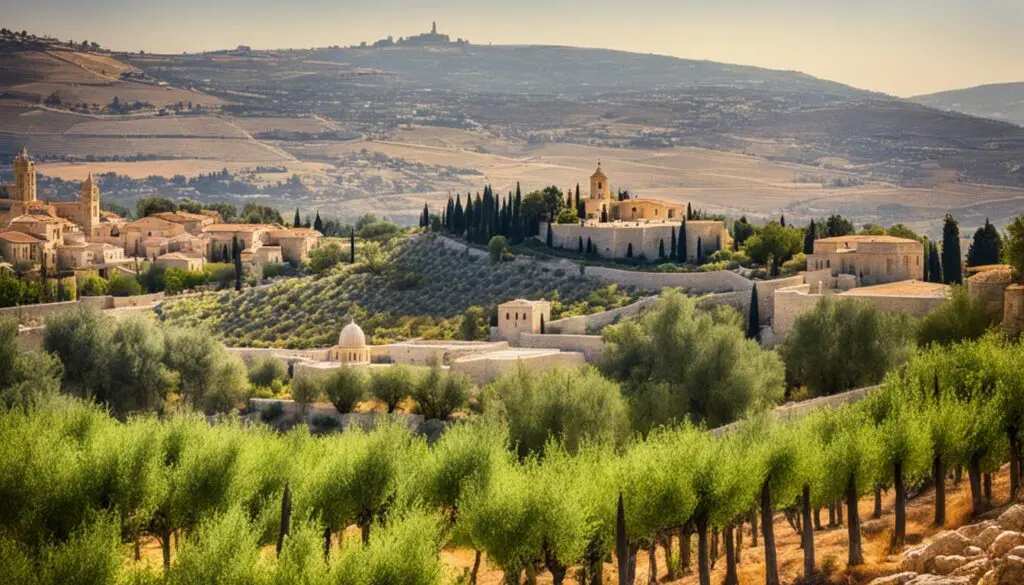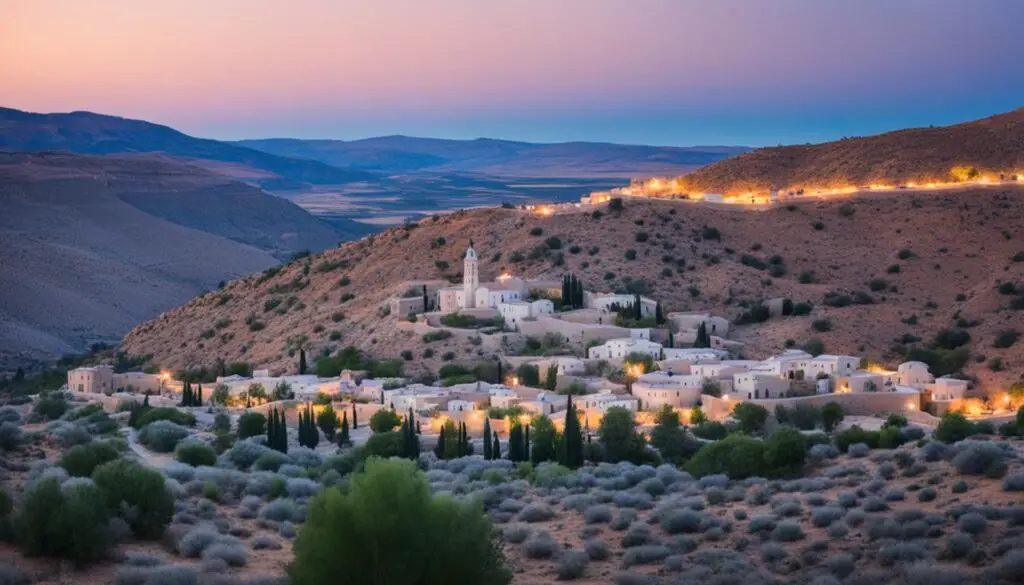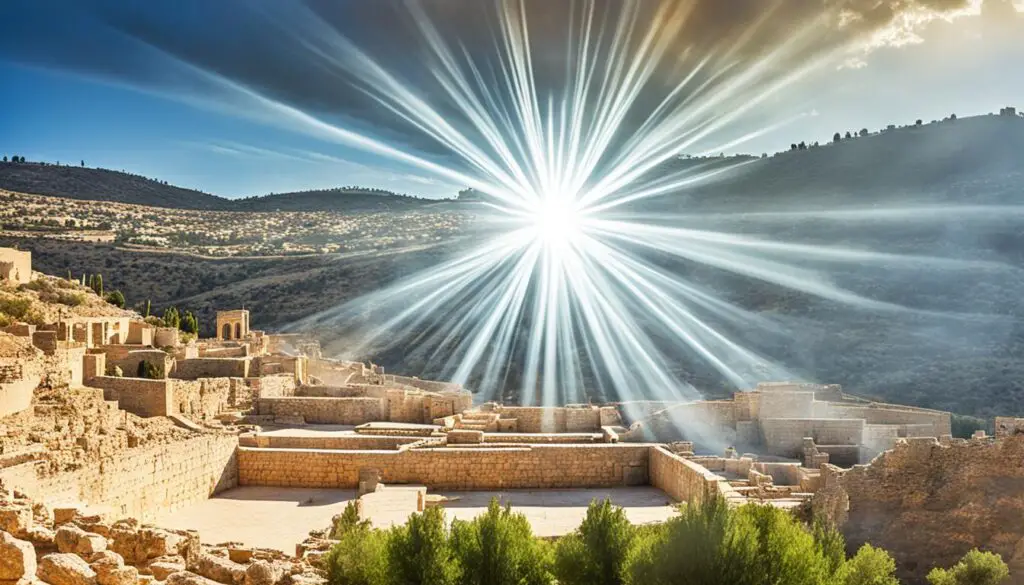Welcome to our exploration of Bethany, a village that holds great significance in the Bible. Mentioned multiple times in the New Testament, Bethany plays a crucial role in the biblical narrative and offers valuable insights into the life and teachings of Jesus Christ.
Key Takeaways
- Bethany is mentioned in the New Testament and is associated with Jesus’ friends Martha, Mary, and Lazarus.
- Jesus performed miracles in Bethany, including the raising of Lazarus from the dead.
- Bethany’s proximity to Jerusalem allowed Jesus to retreat there while still being accessible for his ministry and teachings.
- The village of Bethphage, located between Bethany and Jerusalem, is mentioned in connection with Jesus’ triumphal entry into Jerusalem on Palm Sunday.
- Bethany holds theological themes such as Jesus’ divine authority over life and death and the hope of resurrection and eternal life.
The Geographical Location of Bethany and Bethphage
Bethany and Bethphage, two significant villages in the Bible, hold a notable geographical location in the region of the Mount of Olives. Bethany is situated on the southeastern slope of the Mount of Olives, approximately two miles from Jerusalem. This close proximity allowed Jesus and his disciples to conveniently retreat to Bethany while still being within the vicinity of the city for their ministry and teachings.
Bethphage, meaning “house of unripe figs,” is a village located on the Mount of Olives between Bethany and Jerusalem. This village holds historical and biblical significance, as it is mentioned in connection with Jesus’ triumphal entry into Jerusalem on Palm Sunday.
Historical Significance of Bethany
Bethany, situated near Jerusalem, holds immense historical significance in the biblical narrative. The village is closely associated with Jesus’ ministry and teachings, playing a pivotal role in several key events recorded in the New Testament.
“Bethany holds historical significance due to its association with Jesus’ ministry and teachings.”
One of the notable events in Bethany is the miraculous resurrection of Lazarus. As recorded in John 11, Jesus arrived in Bethany after Lazarus had been dead for four days. By raising Lazarus from the dead, Jesus demonstrated his divine power over life and reaffirmed his authority as the Son of God.
Another significant event that took place in Bethany is the anointing of Jesus’ feet with costly perfume by a woman. This act of devotion, as mentioned in John 12, not only symbolized Jesus’ impending crucifixion and burial but also highlighted the deep love and adoration that his followers had for him.
Bethany’s proximity to Jerusalem, along with its neighboring village Bethphage, is also of historical importance. These villages provided rest and accommodations for pilgrims traveling to Jerusalem for religious festivals and events.
To understand the historical significance of Bethany, it is crucial to examine the cultural and religious practices of the time, as well as the geographical context in which the village thrived.
Bring to life the historical importance of Bethany with the accompanying image:

Archaeological Discoveries in Bethany
While there may not be specific archaeological discoveries in Bethany mentioned in the sources, the village’s identification as al-Azariya in modern-day West Bank suggests a continuous historical connection. The remains of the church dedicated to Lazarus, Mary, and Martha bear witness to the events recorded in the Bible and the deep connection between the people of the Holy Land and these events.
Note: The image above depicts the remains of the church dedicated to Lazarus, Mary, and Martha in Bethany.
Although there may not be extensive archaeological findings specific to Bethany, the identification of the village as al-Azariya in modern times lends credibility to its historical significance. The presence of the church dedicated to Lazarus, Mary, and Martha reinforces the biblical accounts and establishes a tangible link between the events recorded in the Bible and the region of Bethany.
Although archaeological research in Bethany may be limited, the recognition and preservation of the church and its remains contribute to our understanding of the biblical narrative and the lives of those who lived in Bethany during the time of Jesus.
| Archaeological Discoveries in Bethany | Description |
|---|---|
| Remains of the church | Testify to the events recorded in the Bible and the connection to Lazarus, Mary, and Martha. |
| al-Azariya identification | Indicates a continuous historical connection to the biblical Bethany. |
Theological Themes in Bethany
The stories of Bethany in the New Testament are rich in theological themes that offer insights into the life and ministry of Jesus Christ. These themes encompass elements such as Jesus’ divine authority over life and death, the preparation for his burial, and the hope of resurrection and eternal life.
In Bethany, Jesus showcased his power and authority through miraculous acts, illustrating his divine nature. One notable event was the resurrection of Lazarus, which demonstrated Jesus’ dominion over death and his ability to bring life back to the dead.
Another significant theological theme is the preparation for Jesus’ burial. In Bethany, a woman anointed Jesus’ feet with expensive perfume, foreshadowing his impending death and burial. This act symbolized the recognition of Jesus’ sacrificial love and his role as the ultimate sacrifice for the redemption of humanity.
The stories from Bethany also provide hope for believers in the promise of resurrection and eternal life. Jesus’ connection with Martha, Mary, and Lazarus highlights the eternal bond and the assurance of life beyond the earthly realm.
“I am the resurrection and the life. The one who believes in me will live, even though they die; and whoever lives by believing in me will never die.” – John 11:25-26
The miracles and teachings in Bethany serve as powerful reminders of the theological truths embedded in the Gospel narratives. They emphasize the divinity and redemptive mission of Jesus Christ, offering comfort, encouragement, and hope to believers throughout history.

| Theological Themes in Bethany |
|---|
| 1. Divine authority over life and death |
| 2. Preparation for burial |
| 3. Hope of resurrection and eternal life |
Key Biblical Events in Bethany
In the village of Bethany, several key biblical events unfolded, shedding light on the power and love of Jesus Christ. These events demonstrate his authority over life and death, and his deep connection with his friends.
The Raising of Lazarus
One of the most significant events in Bethany is the miraculous raising of Lazarus from the dead. Jesus, moved by his love for Lazarus and his sisters, Mary and Martha, called Lazarus out of the tomb, restoring him to life after being dead for four days.
The Anointing of Jesus’ Feet
Another momentous event in Bethany was when a woman anointed Jesus’ feet with expensive perfume, an act of deep reverence and adoration. Jesus acknowledged the woman’s act of faith and prophesied that her act would be remembered throughout history.
Jesus’ Visits to Mary, Martha, and Lazarus
Bethany was also a place where Jesus found solace and friendship. He frequently visited the home of Mary, Martha, and Lazarus, enjoying their company and sharing precious moments of fellowship and teaching. These visits showcased the love and authentic relationships Jesus cultivated with those around him.
These key biblical events in Bethany showcased Jesus’ power, authority, and love for his friends. They serve as profound reminders of his divine nature and his profound impact on the lives of those he encountered.

Cultural and Religious Practices in Bethany
While specific cultural and religious practices in Bethany are not mentioned in the sources, the village’s proximity to Jerusalem suggests that it would have been influenced by the practices of the larger city. As a place of pilgrimage and a home to followers of Jesus, Bethany would have had a unique blend of traditions and customs.

“Bethany, being in close proximity to Jerusalem, would have undoubtedly been influenced by the cultural and religious practices of the city. As a place of residence for beloved biblical figures such as Martha, Mary, and Lazarus, it would have been a hub of spiritual devotion, prayer, and communal gatherings. Pilgrims visiting Bethany would have engaged in various rituals and ceremonies, and the local community would have preserved their religious customs with utmost reverence.”
– Renowned biblical scholar
Without explicit textual evidence, we can only speculate about the specific practices that were followed in Bethany. However, considering its role as a significant site in biblical narratives and its connection to Jerusalem, it is reasonable to assume that the cultural and religious practices in Bethany would have been deeply rooted in Judeo-Christian traditions.
Possible Cultural and Religious Practices in Bethany:
- Pilgrimages: Given Bethany’s association with Jesus and its proximity to Jerusalem, it is likely that the village attracted pilgrims from various regions who sought spiritual enrichment and connection to the biblical events that took place there.
- Community Gatherings: The tight-knit community in Bethany would have come together for religious activities, such as communal meals, prayer, and fellowship.
- Observance of Jewish Festivals: As Jesus and his disciples were Jewish, it is plausible that the people of Bethany would have celebrated annual Jewish festivals such as Passover and Sukkot, along with other significant events on the Jewish calendar.
- Worship and Devotion: The home of Martha, Mary, and Lazarus would likely have been a center of worship and spiritual devotion for the residents of Bethany, with regular prayer meetings and gatherings to study scripture.
- Acts of Service and Generosity: Mary’s anointing of Jesus’ feet with expensive perfume in Bethany exemplifies acts of service and sacrificial giving, which may have been integral to the cultural values of the village.
| Cultural and Religious Practices in Bethany | Religious Influence from Jerusalem | Pilgrimage to Bethany |
|---|---|---|
| The residents of Bethany would have followed cultural practices, rooted in Judeo-Christian traditions. | As Bethany was close to Jerusalem, the religious practices of the larger city would have influenced the village. | Pilgrims would have journeyed to Bethany to connect with the biblical events that occurred there. |
| The community in Bethany would have engaged in communal gatherings, prayer, and devotion. | Jerusalem’s religious customs and festivals would have been observed by the people of Bethany. | Bethany served as a place of pilgrimage for spiritual enrichment and connection to Jesus’ ministry. |
| Acts of service, generosity, and faith would likely have been integral to the village’s cultural values. | The religious significance of Jerusalem would have influenced the spiritual practices of Bethany. | Pilgrims would have participated in religious rituals and ceremonies during their visit to Bethany. |
While the specifics of cultural and religious practices in Bethany remain unknown, it is evident that the village held a special place in the hearts of believers and was a site of great spiritual significance.
Prophetic and Eschatological Significance of Bethany
The sources may not explicitly mention the prophetic or eschatological significance of Bethany. However, its location on the Mount of Olives, which is prophesied to be the site of Jesus’ second coming, suggests a potential eschatological significance for the village.
The Mount of Olives holds great biblical significance, and its association with Bethany adds depth to its prophetic implications. In the book of Zechariah 14:4, it is written: “On that day his feet will stand on the Mount of Olives, east of Jerusalem, and the Mount of Olives will be split in two from east to west, forming a great valley, with half of the mountain moving north and half moving south.” This prophecy points to a future event where Jesus will return to the earth and bring about the ultimate fulfillment of God’s plan.
Bethany’s proximity to the Mount of Olives positions it in the realm of eschatological significance. While the sources do not provide explicit explanations, the connection between Bethany and the prophetic expectations surrounding the Mount of Olives implies a potential role for Bethany in the unfolding of God’s future plans.
Although further research and interpretation are needed, the geographical and biblical backdrop of Bethany invites contemplation on its prophetic implications and its place within eschatological narratives.

Emphasizing the prophetic aspects of Bethany can deepen our understanding of biblical eschatology and inspire reflection on the larger framework of God’s plan for humanity’s redemption and restoration.
Conclusion
Bethany, with its historical and geographical context, holds immense significance in the Bible. It is mentioned several times in the New Testament as the home of Jesus’ friends Martha, Mary, and Lazarus. The village’s proximity to Jerusalem and its connections to the Mount of Olives amplify its importance in the biblical narrative.
During his time in Bethany, Jesus performed miracles such as raising Lazarus from the dead and was anointed by a woman with precious perfume. These events highlight Jesus’ divine power and sacrificial love, reminding us of the central themes of Christianity. Additionally, Bethany serves as a symbol of hope, teaching us about the resurrection and the promise of eternal life.
While specific archaeological discoveries in Bethany may not be mentioned in the sources, the identification of the village as al-Azariya in modern-day West Bank signifies an ongoing connection between the ancient biblical narrative and the present. The remains of the church dedicated to Lazarus, Mary, and Martha further attest to the historical and spiritual relevance of the village.
Overall, Bethany’s significant role in the Bible, its historical context, and its ties to Jesus’ ministry make it a crucial location for understanding the teachings and message of Christianity. The stories and events associated with Bethany provide valuable insights into the life, power, and love of Jesus Christ.







